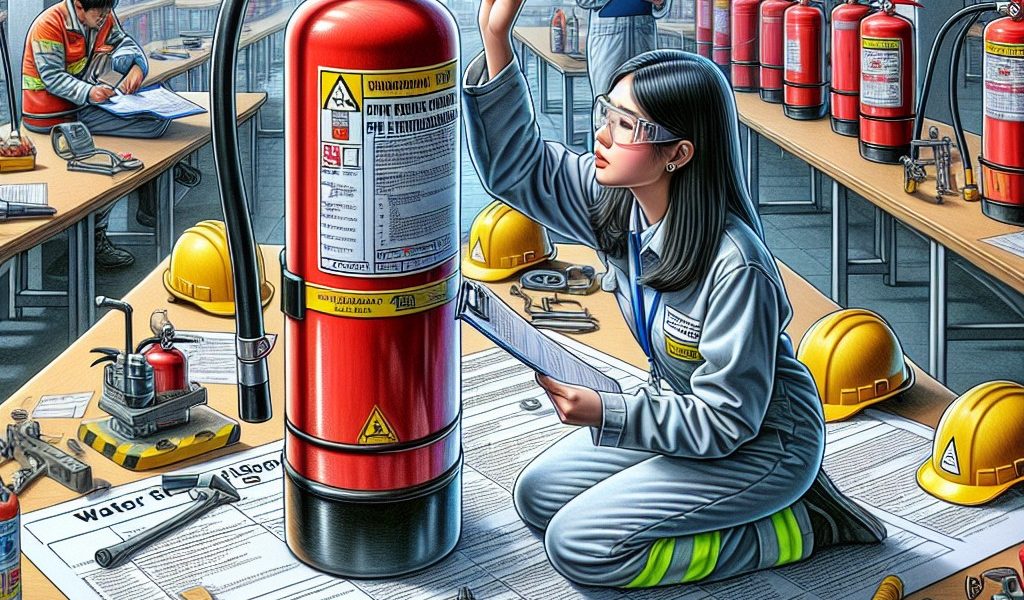Decoding the Regulations and Detailed Procedures of Inspecting a Water Fire Extinguisher
Introduction
Water extinguishers are essential devices for preventing and fighting fires in professional and residential buildings. In order to guarantee their effectiveness when necessary, it is crucial to respect certain standards and regulations regarding their verification. In this article we present a detailed guide on the procedures for checking a water fire extinguisher, in accordance with current regulations.
Applicable regulations and standards
Several texts govern the installation, use and maintenance of fire extinguishers in France:
- The Labor Code (articles R. 4227-28 to R. 4227-39) which requires employers to equip their premises with first intervention means adapted to the risk.
- The Public Health Code (article L.1311-6) which makes it compulsory to install fire extinguishers in certain establishments open to the public (ERP).
- The National Institute for Research and Safety (INRS), a leading organization for the prevention of workplace accidents, which publishes recommendations on the choice, location and maintenance of fire extinguishers.
- The Plenary Assembly of Damage Insurance Companies (APSAD), which publishes certification rules for companies specializing in the maintenance of fire extinguishers.
- Standard NF S 61-919, relating to the maintenance and periodic checks of portable and mobile fire extinguishers.
The different types of controls necessary
Two levels of verification are required to ensure the proper functioning of a fire extinguisher:
- User inspection: This is a quick visual check carried out regularly by site staff. It ensures that the fire extinguisher is in place, accessible, visible and in apparent good condition. The user must also check that the device has not been used or damaged (sealing intact, pressure gauge indicating correct pressure, etc.).
- Maintenance by a competent person: this more in-depth operation must be carried out at least once a year by a qualified technician. It notably includes a check of the weight, body and internal mechanism of the device, as well as a functional test on certain models.
Recommended frequency for these operations
According to standard NF S 61-919, here are the minimum frequencies recommended for each type of verification:
- For visual inspection by the user: at least once a month.
- For annual maintenance: every year with a tolerance of 3 months (i.e. a maximum period of 15 months between two maintenances).
How to perform annual maintenance on a water fire extinguisher
Annual maintenance must be carried out by a qualified technician, in accordance with the manufacturer’s instructions and the requirements of standard NF S 61-919. Here are the main steps to follow during this verification:
- Check the labeling, marking and signage of the fire extinguisher.
- Visually check the general condition of the body, accessories and fixings.
- Weigh the device to ensure that its weight conforms to the manufacturer’s instructions.
- Open the fire extinguisher (after depressurizing if necessary) to inspect the internal mechanism, the tank and the seals.
- Check the proper functioning of the non-return device and/or valve(s) if they are present on the fire extinguisher concerned.
Note : For certain models of permanently pressurized water extinguishers with antifreeze additive, it may be necessary to carry out a functional test by partially or completely draining the contents.
Qualifications required to carry out these inspections and maintenance
The user responsible for visual inspections must have a minimum knowledge of the rules applicable to fire extinguishers as well as practical training in their handling. Annual maintenance must be carried out by a qualified technician, having followed specific training and having experience in this field. Maintenance companies must be APSAD certified or equivalent.
Importance of tracking checks in a security register
All verification and maintenance operations must be recorded in a safety register, kept up to date and accessible to the competent authorities in the event of an inspection. This document must include:
- The dates of visual inspections and maintenance carried out.
- The names and qualifications of the people who carried out these operations.
- The result of the checks (satisfactory condition or anomaly noted).
- Corrective measures taken if necessary (replacement, repair, etc.).
To conclude, checking a water fire extinguisher is an essential operation to guarantee fire safety in buildings. By scrupulously respecting applicable standards and regulations, you help to effectively prevent fire risks and protect people and property.

